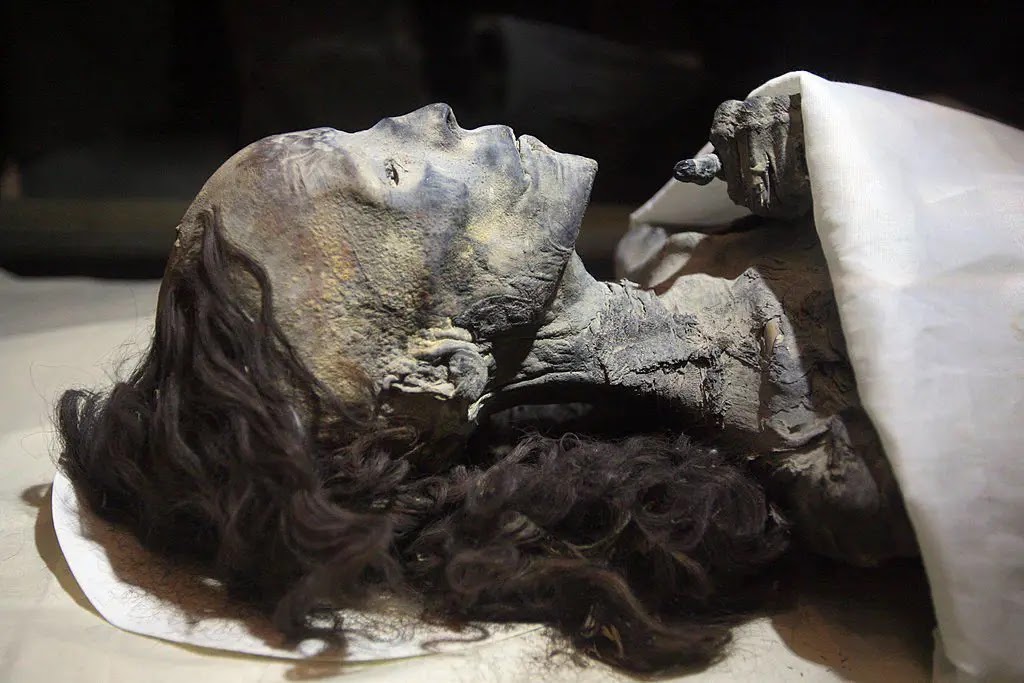The image of the Egyptian Queen Tiye aroused the admiration of millions, especially when it was spread on social medias, and the question that baffled many became how the ancient Egyptians were able to preserve the features of mummies, especially hair, to remain evidence of their civilization even after the passage of thousands of years? While the women had other questions about how to care for hair in ancient Egypt using natural methods.
Queen Tiye lived in 1398 BC, her father Yuya was a regional priest in the town of Akhmim, he also worked as a captain of the royal chariots, he owned a large piece of land, and was considered one of the richest Egyptians at that time.
Queen Tiye later married Amenhotep III, and bore at least 7 children, among them Amenhotep IV “Akhenaten”.
We are in front of a queen who has a team working in her service to take care of her beauty, so how did the queens in the ancient era care about hair and skin?
Even though queens wear wigs; But it is known that the Egyptians used essential oils for hair and skin freshness, as the hair was wrapped with beeswax and other fatty materials, as beeswax was very expensive, and only the kings and nobles used it.
The hairstyles of the mummies varied between long and short, with curls in particular, and metal tools resembling tweezers were found in many cemeteries. Once styled, natural greases were used to hold curls in place.
Egyptians also used “henna” (also used for nails and lips) to dye their hair red, and historical research shows that the Egyptians used henna to hide gray hair since 3400 BC.
There is also evidence of paintings depicting the presence of people with distinct red hair in the 18th family, according to Kozo Takahashi, of Minnesota State University.
Women’s hairstyles were more unique than men’s hairstyles. Women generally preferred a smooth hairstyle with a natural wave, and women in the Old Kingdom preferred to have short haircuts. However, women in the New Kingdom (1550-1070 BC) wore a wig, and also tied their hair and embellished it with roses and linen ribbons.
The stylized lotus flower was the favorite decoration for the head, from which this evolved into the use of crowns and wreaths, and crowns made of gold, turquoise, agate and malachite beads were discovered on an ancient Egyptian body dating back to 3200 BC.
Poorer people used simple, inexpensive motifs of petals and berries to hold the hair in the back.
Children also decorated their hair with amulets of small fish, supposed to protect them from the dangers of the Nile.
The Egyptians also wore headbands on their heads or fixed their hair with ivory and metal hairpins, and beads could be used to tie wigs or hair extensions.
Hair loss treatment
As is the case today, the ancient Egyptians were also facing the same problem of hair loss, and they wanted to maintain their youthful appearance for as long as possible.
The Egyptians used many types of remedies aimed primarily at men to treat baldness.
It is believed that in 1150 BC, men used caribou oil, lions, crocodiles, snakes and hippos on their scalps.
They are also credited with using cat fat, goat fat, and chopped lettuce to treat baldness and stimulate hair growth.
Returning to the natural products that Egyptians used in hair care, studies indicate their use of essential oils such as rosemary oil, almond oil (sweet), and castor oil to stimulate hair growth.
They also used fenugreek seeds, which herbalists and pharmacologists still use today.
Ancient Egyptian “hair gel”
An analysis of mummies announced in 2011 revealed that ancient Egyptians had straightened their hair with a grease-containing gel.
The researchers who conducted the study said the Egyptians used the product to make sure their hair stayed the way they wanted in life and death.
The study was led by Natalie C. McCreesh, an archaeologist and specialist in Egyptology at the University of Manchester in Britain, and her team studied hair samples from 18 mummies, the oldest of which was about 3,500 years old, and included males and females between the ages of 4 to 58 years.
Some were artificially mummified, others were preserved naturally by the dry sand in which they were buried.
Microscopy using light and electrons revealed that 9 of the mummies had hair covered in a mysterious, fat-like substance.
The researchers used the gas chromatography technique to separate the different molecules in the samples, they found that the coat contains biological fatty acids including palmitic acid and stearic acid.
McCreesh believes greasy paint is a styling product that has been used to hold hair in place. It is found in both natural and artificial mummies; So you think it was one of the beauty products during life and an essential part of the embalming process.
The resins and embalming materials used in the preparation of artificially mummified carcasses were not found in the hair samples; This indicates that the hair was protected during mummification and was then styled separately. “They may have paid special attention to hair because they realized that it does not degrade like the rest of the body,” McCreesh says.
Sources:
- https://historicaleve.com/all-facts-about-egyptian-queen-tiye-mother-of-akhenaten/
- https://link.springer.com/referenceworkentry/10.1007%2F978-1-4020-4425-0_9456

